Kidding In Goats
Kidding, the act of the birthing process in goats, shown in Figures 8-1, 8-2 and 8-3, is the culmination of the breeding process in goats. Kidding represents the finale of the approximately 150-day gestation period in the breeding doe.
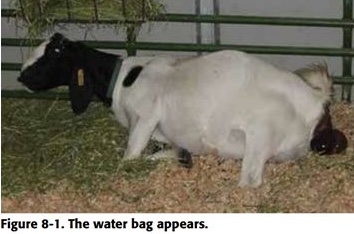
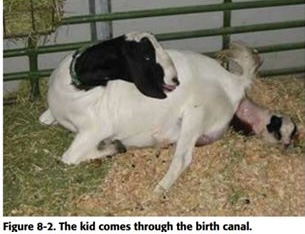
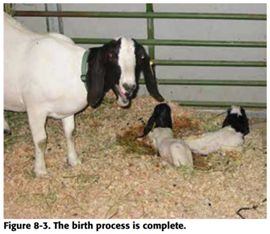
Kidding
Close to the end of the gestation period, grazing the pregnant does nearby helps producers easily check on them. Any supplement of concentrate or hay should be fed to the does at night. Late feeding can delay birthing to the early morning hours in the majority of animals. Have some kidding pens ready for weak kids or reluctant mothers. Prekidding signs in goats are not always easy to detect; however, mucous discharge is a sure sign that kidding is close.
Kidding Process
There are three stages of the kidding process. Stage one is the preparatory stage. During this stage, the kid should rotate into the upright position and the cervix will start to dilate. The doe will become restless as her uterus starts to contract. This stage can last between four to eight hours with mature does and six to 12 hours with doe kids (first time mothers).
Stage two is the delivery stage. The water sac will appear first as the kid enters the birth canal. The water sac will then rupture and the front feet and head should appear. Then the kid is delivered. This stage should take less than one hour for mature does, but can take up to four hours for doe kids.
Stage three is the cleaning stage. The doe’s straining decreases as the attachment between the uterus and placenta relaxes and separates. The placenta then is expelled from the doe. The placenta is commonly referred to as the afterbirth. This stage can last from one to eight hours.
All three stages should take place with little to no assistance from the producer, although sometimes it is necessary to lend assistance. Generally this assistance will be during stage two of the kidding process. Determination of when assistance is needed is sometimes difficult and usually requires close observation.
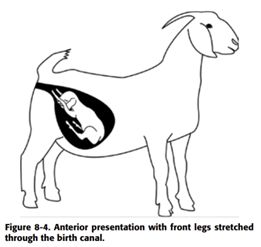
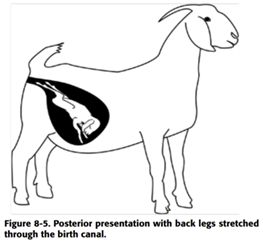
Normal Births
In goats, the kids can be delivered in two normal presentations. Figure 8-4 shows the anterior presentation. The kid’s head is first with the front legs extended out of the birth canal. A majority of births occur this way. Unless the kid is too big for the birth canal, no assistance should be needed. Figure 8-5 shows the posterior presentation with the hind legs extended through the birth canal and the back end coming first. This is normal and a doe should be able to have the kid with no assistance. It is when the presentation is not normal that assistance may be needed.
Abnormal Presentations
If a doe begins stage two of the kidding process and the kid or kids are not positioned in a normal presentation the doe could have difficulty giving birth. Figure 8-6 shows some of the abnormal ways a kid can be positioned. If a kid is positioned abnormally, it must be repositioned to a normal presentation before it can be delivered. This requires assistance from the producer or a veterinarian.
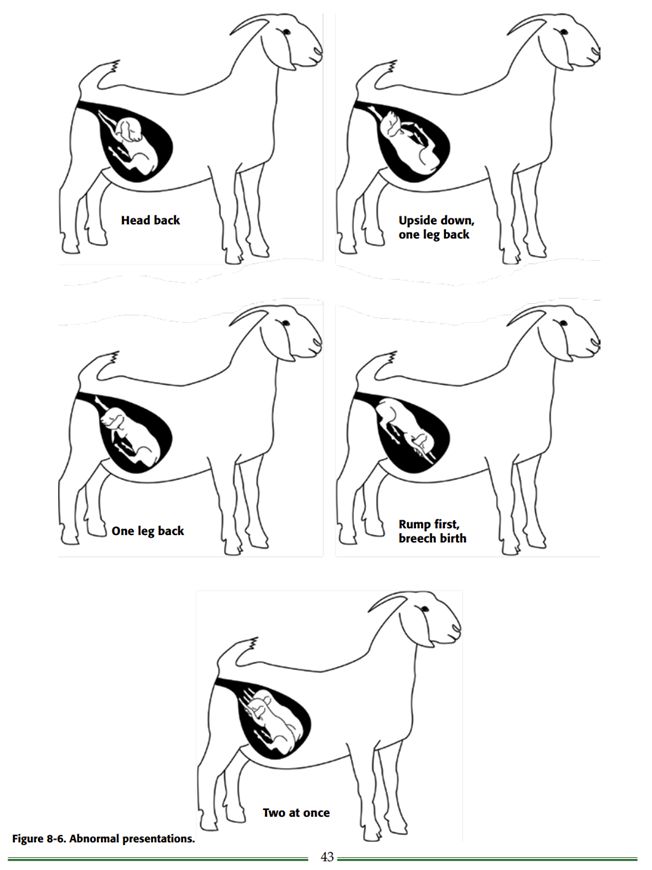
When To Lend Assistance
Once the doe enters stage two, a producer should watch her very closely. Some does can deliver their kids quickly and some may take up to 2 hours. Unless a producer is closely observing the doe, it may be difficult to determine how long she has been straining. It is recommended not to allow a doe to strain hard for more than 30 minutes. Many times the doe will stop straining and the uterus may contract around the kid.
How To Assist
Once it is determined that a doe needs assistance, the producer must choose to do it themselves or have it done by a veterinarian. If the kid is abnormally positioned that position must be corrected. This requires inserting the producer’s hand into the birth canal and uterus to reposition the kid.
Now the birth canal of a goat is relatively small when compared to the average hand of producers. This size difference could cause another source of frustration because if a producer is unable to get their hand into the birth canal, they will not be able to reposition the kid.
When To Stop
After attempting to reposition or pull the goat through the birth canal for 30 minutes and a producer has not been successful, it is time to get professional help. Although commercial goats may not be valuable enough to justify a large veterinary bill, producers should consider the potential value of future breeding when making this decision.
